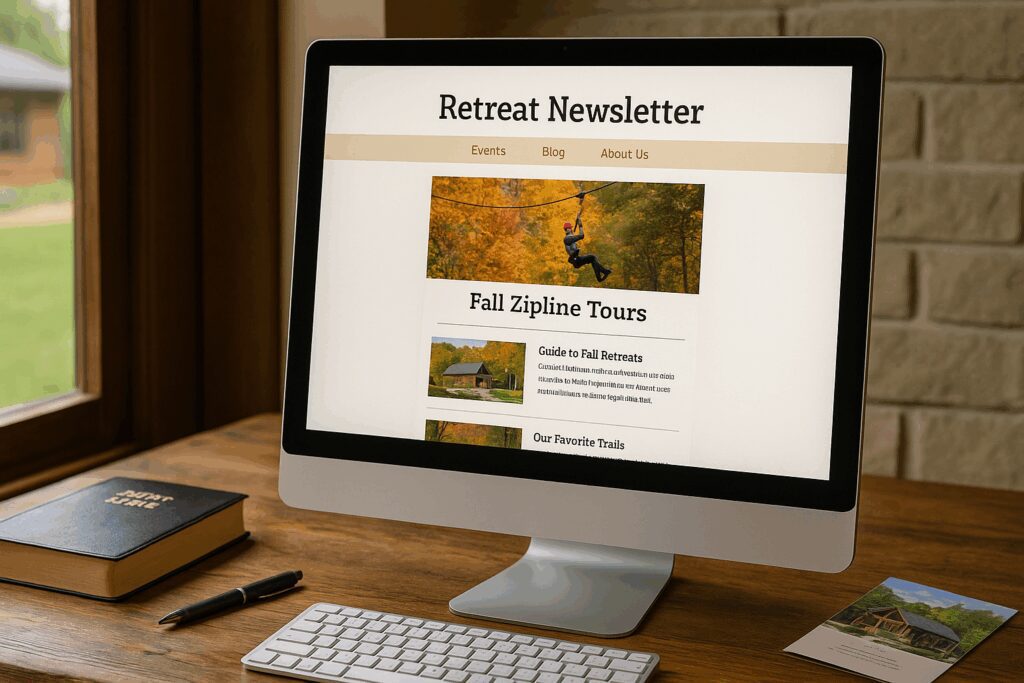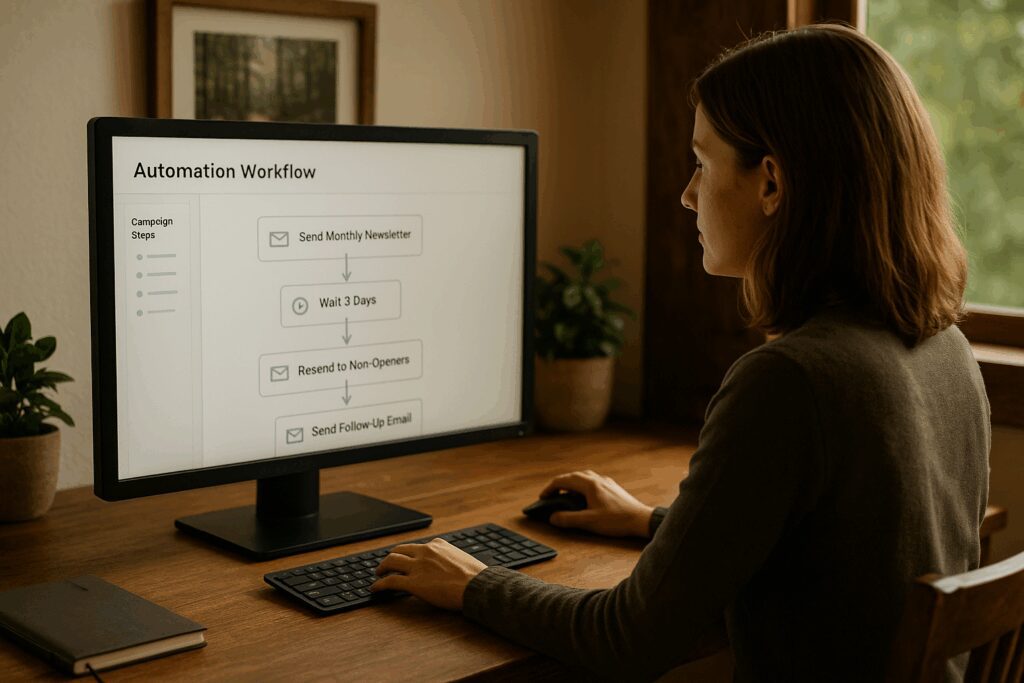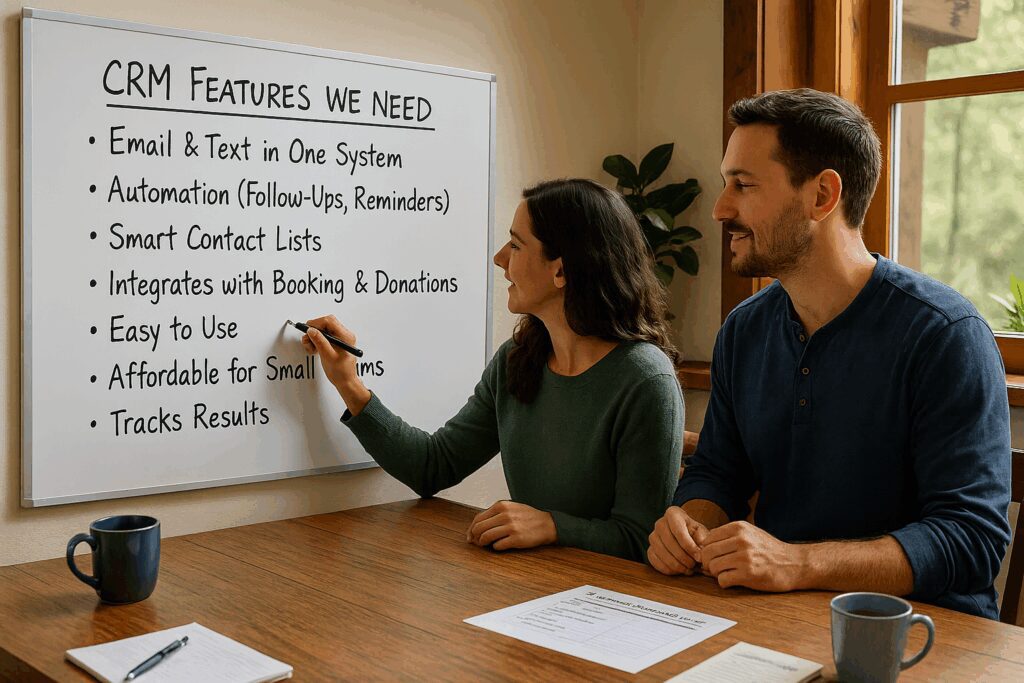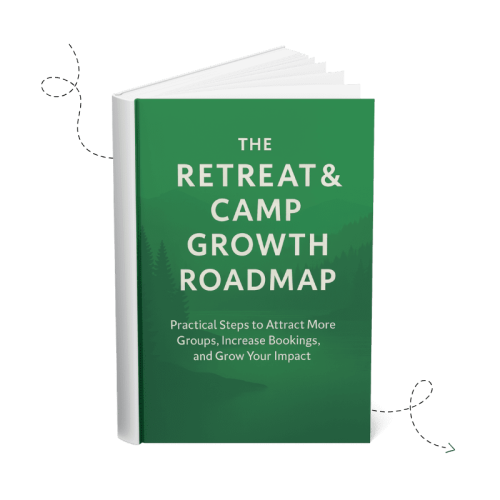Retreat & Camp Growth Roadmap Focus Area: Send Email & SMS Blasts
Introduction
Keeping your retreat center’s calendar full isn’t just about attracting new groups—it’s also about nurturing the relationships you’ve already built. Past guests, retreat organizers, and donors are far more likely to return if you stay present in their minds. Email and SMS are two of the most effective ways to do this. Unlike social media, which depends on shifting algorithms, these channels put your message directly into inboxes and phones, where it’s most likely to be seen.
Every message you send is a chance to extend the retreat experience beyond your grounds. Done consistently, email and SMS keep you connected year-round, encourage rebookings, inspire donors, and give your ministry a steady presence in people’s lives.
Why This Focus Area Matters
For retreat centers, communication is more than a marketing tactic—it’s a ministry opportunity. Each message is a small reminder of the impact your space has had on guests and groups. A youth pastor who led a retreat last summer may only think to rebook when they see your name in their inbox. A past guest might forward your newsletter to a friend planning a family reunion. A donor might feel compelled to give again after reading a testimony of lives transformed at your facility.
By investing in consistent communication, you practice stewardship of the audience God has already entrusted to you. These simple touchpoints nurture trust, strengthen relationships, and often turn into new bookings, donations, or referrals.
Is This an Area You Need to Focus on Right Now?
Before you decide where to spend your time, ask yourself a few simple questions:
- Do you have maintain an updated list of past guests?
- Do you send out a regular email or text blasts to past guests?
- Do your email or text blasts get opened at the expected rate?
- Do your emails or texts drive new bookings?
If you answered “no” to any of these, this focus area can help you bring greater clarity, alignment, and impact to your outreach.
The beauty of email and SMS campaigns is that you don’t need a big marketing team to succeed. You just need a rhythm. Even small improvements in consistency can create a stronger year-round presence and healthier engagement.
Putting This Focus Area into Practice
You don’t have to become a marketing expert overnight. The key is to build communication into your routine step by step. Start with the basics, then add layers of sophistication as you gain confidence. Here’s a clear progression you can follow.
List Management Best Practices
Every effective email and text strategy begins with a strong, healthy contact list. Before you can send meaningful messages, you need to know who you’re reaching and where those names are coming from. Most retreat centers already have rich contact information spread across different systems—registration forms, event sign-ups, and donation records—but often it’s not consolidated in one place.
Start by identifying your main sources of contacts. These often include camp registrants, who sign up for summer camps or day programs; retreat guests, who attend church, family, or corporate retreats; event participants, who join in for seasonal activities like banquets, adventure programs, or open houses; donors, who support your ministry financially or through volunteer service; and inquirers, those who fill out a contact form, download a resource, or call to ask about retreats or events.
As you collect these contacts, make sure every form you use—whether for registration, inquiry, donation, or waivers—includes a simple opt-in checkbox for your newsletter or updates. This ensures each contact has given permission to receive communication from you, keeping your outreach trustworthy and compliant.
Once your contacts are gathered, maintaining the list is just as important as building it. Use a centralized CRM system, such as LeadHub CRM, to keep everything organized. Regularly remove bounced or inactive emails, and encourage subscribers to update their preferences instead of unsubscribing altogether. Periodically review data for accuracy—especially for group leaders, as roles often change within churches and schools. A clean list not only improves deliverability but also preserves your reputation and credibility.
After your list is healthy and up to date, the next step is segmenting it into groups based on shared characteristics. Common segments include retreat organizers, who plan group events and need timely booking information and facility updates; past guests, who respond best to personal invitations, devotionals, or news about new activities; donors, who appreciate impact stories and ministry updates; camp families, who want to hear about registration deadlines and new programs; and community contacts, who may attend open houses or special events.
You can also segment by engagement level. For example, active subscribers regularly open and click your emails, while dormant subscribers may need a re-engagement message. Recent inquirers can receive a series of nurturing emails that help them take the next step toward booking a retreat.
Segmenting your list allows you to send the right message to the right people at the right time. It makes every email and text more relevant and personal—something your audience will appreciate.
Finally, a few simple practices will keep your list healthy long-term. Always use permission-based marketing and never add people without their consent. Automate list updates whenever possible, such as tagging contacts based on form submissions. Review your list quarterly to remove inactive addresses and identify growth opportunities.
Building, maintaining, and segmenting your list might not sound exciting, but it’s one of the most valuable disciplines you can develop. A well-managed list isn’t just a marketing tool—it’s a community of people already connected to your mission and ready to engage with it again.

Send Monthly Newsletters
Consistent newsletters are one of the simplest and most effective ways to stay connected with your audience. They remind guests, organizers, and donors that your retreat center is active, engaged, and ready to serve. Ideally, you should send a newsletter once a month, but if that feels overwhelming, start quarterly and work your way up. The most important thing is consistency—people can’t remember you if they never hear from you.
A regular newsletter keeps your ministry visible between visits. Even a short update can rekindle a connection or inspire someone to reach out. Over time, your audience will begin to expect your updates and appreciate hearing from you in a familiar, friendly format.
When you’re ready to begin, keep the structure simple and repeatable. A good formula for retreat centers is to include:
- A short introduction from the director. This could be a reflection, ministry update, or personal note that sets the tone.
- A featured blog article or story. Choose something that informs or inspires—like a recent retreat testimony, a seasonal devotional, or a behind-the-scenes look at your programs.
- A promotional feature. End with a timely call to action, such as an early-bird special, an upcoming community event, or a reminder to book retreats for next season.
Every newsletter should also include consistent calls to action, like “Reserve Your Spot,” “Learn More,” or “Plan Your Retreat.” Don’t forget to add your contact information and links to your social media accounts at the bottom so readers have an easy way to stay connected.
To make planning easier, create a newsletter calendar that outlines your content for the year. Map out your director’s notes, featured topics, and promotions ahead of time so you’re never starting from scratch. Align each newsletter with seasonal relevance. For example:
- September: A director’s note about back-to-school and the shift to fall ministry rhythms, a featured blog about fall activities or leadership retreats, and a promo highlighting a fall community event at your property.
- December: A Christmas greeting from the director, a devotional or blog about reflection and rest, and a promo for upcoming winter retreats or banquets.
- April: A note about renewal and new beginnings, a blog about spring events or facility updates, and a promo for summer camps or family retreats.
A calendar not only helps you stay organized but also ensures that your messages stay relevant to your guests’ lives and your ministry’s seasonal focus.
When it comes to choosing a platform, you have two main options. Many retreat centers start with standalone tools like Constant Contact or Mailchimp. These are simple to use and great for basic newsletters, especially when you’re getting started. However, as your needs grow, you may benefit from using a CRM-based system like LeadHub CRM, which integrates your contact lists, automations, and communication all in one place. A tool like this allows you to see who opened your newsletter, who clicked, and even who booked a retreat afterward—all within the same dashboard.
Remember, your first few newsletters won’t be perfect—and that’s okay. The key is to start, learn, and refine as you go. With each issue, you’ll become more confident, your communication will become more natural, and your readers will look forward to hearing from you. The most successful retreat centers aren’t the ones with the flashiest emails—they’re the ones that show up consistently and communicate with heart.

Use Promotional Emails and Text Blasts
While newsletters help you stay connected, promotional emails and text blasts are your best tools for driving specific action. These are the messages that encourage guests to book a retreat, sign up for a program, or participate in a special event. Unlike newsletters—which focus on relationships and storytelling—promotional campaigns focus on invitations and opportunities.
Sending separate emails or texts for specific activities, events, or seasonal promotions allows you to highlight one clear call to action and make it easy for readers to respond. When everything isn’t competing for attention in one message, your promotions feel more personal, purposeful, and relevant. For example, an email about an upcoming fall banquet or a new zipline tour will perform better when it’s focused on that single opportunity rather than buried in a long newsletter.
This is where segmentation becomes essential. When you send a message that’s tailored to a specific audience, engagement increases dramatically. Past zipline customers will appreciate hearing about new adventure experiences, while retreat organizers will respond to offers like midweek rates or early booking specials. Segmenting your lists ensures each message goes to the right people—those most likely to care and respond.
When deciding between email and text, think about timing and context. Email is ideal for messages that need explanation, visuals, or multiple links—like event details, lodging information, or registration forms. Text messages, on the other hand, are best for short, time-sensitive reminders such as “Early bird pricing ends Friday” or “Just three cabins left for our winter retreat.”
Sometimes the best approach is to use both together. For instance, you might send an email with all the details about a community event, followed by a short text reminder the day before: “Looking forward to seeing you tomorrow at the Fall Festival!” Email provides context; SMS provides immediacy.
Here are three examples of effective promotional campaigns for retreat centers and camps:
- Seasonal Booking Campaigns: Encourage retreat organizers to book early for the upcoming season. For example, send a January email titled “Reserve Your Spring Retreat Before February 15 for Special Rates,” followed by a short reminder text closer to the deadline.
- Activity or Event Promotions: Highlight special experiences such as “New High Ropes Adventure Now Open!” or “Family Fun Day Registration Now Live.” These work especially well when sent to past guests who participated in similar activities.
- Special Offers and Limited-Time Discounts: Share timely promotions that fill slow seasons, such as “Midweek Winter Retreat Specials” or “Bring-a-Friend Discount for Returning Guests.” These simple, time-bound offers can help fill gaps in your schedule and keep activity steady year-round.
To increase the effectiveness of your campaigns, you can also use simple automations to follow up—like resending your message to those who didn’t open the first time or sending a reminder to those who clicked but didn’t complete registration. We’ll explore automation strategies more deeply later, but even basic automations can significantly boost engagement and save staff time.
Finally, choosing the right platform makes all of this easier to manage. Whether you use standalone tools like Mailchimp or Constant Contact, or an integrated system like LeadHub CRM, look for solutions that support both email and SMS. We’ll cover software selection in more detail later, but for now, keep in mind that having everything in one place—contacts, communication, and tracking—makes promotional campaigns much more efficient.
Promotional emails and text blasts bridge the gap between awareness and action. By sending focused, well-timed messages to the right people, you can fill retreats, grow participation, and invite more guests to experience your ministry. Start small, track your results, and refine your approach as you go. Consistency and relevance are what turn promotions into genuine ministry connections.

Incorporate Fundraising Campaigns
Fundraising is deeply relational, and personalized communication is at the heart of every successful appeal. Email and text messages allow you to reach your donors directly, share meaningful stories, and invite them to participate in your mission in a tangible way. When done thoughtfully, these messages don’t feel like solicitations—they feel like invitations to be part of something that matters.
A key advantage of email and text communication in fundraising is the ability to make your outreach personal and timely. You can address donors by name, reference past contributions or involvement, and show the real impact their giving has made. A simple message that says, “Because of your generosity last summer, 200 youth experienced life-changing retreats,” reminds donors that they are active partners in ministry, not just financial supporters.
Another key to effective fundraising is the specificity of your campaigns. While general giving appeals have their place, specific campaigns nearly always perform better because they connect to a tangible goal. People respond when they can see the direct impact of their gift. Here are three types of specific campaigns that work well for retreat centers and camps:
- Facility or Project Campaigns: Announce an opportunity to help fund a visible improvement—like new cabins, an updated dining hall, or expanded activity areas. Donors love to see progress they can visit and experience.
- Program Sponsorship Appeals: Invite supporters to underwrite something meaningful, such as youth retreats, family programs, or counselor training. Pair these with testimonies from past participants to make the stories personal.
- Scholarship Campaigns: Many retreat centers thrive on their ability to make retreats accessible. Share stories of guests whose lives were changed by attending and invite donors to make that possible for others.
When planning your fundraising appeals, think carefully about which channel—email, text, or both—will work best for your message. Email is ideal for longer storytelling: sharing photos, testimonies, and updates about how donations make an impact. Texts, on the other hand, are best for time-sensitive or milestone-based updates, such as “We’re just $500 away from our goal—help us finish strong!” or “Thank you! We reached 90% of our scholarship fund today!”
Combining email and text can be especially effective. For example, you might send an email on Monday sharing your year-end impact stories and inviting people to give. Then on Thursday, send a brief text reminder: “There’s still time to make your year-end gift and help more families experience renewal. Thank you for being part of this ministry!” The email tells the story, and the text provides the timely prompt. Together, they create both emotional connection and immediate opportunity.
Segmentation is another powerful tool for your fundraising communications. Not all donors are the same—long-time supporters, first-time givers, volunteers, and corporate sponsors each respond differently. Segmenting your donor list allows you to tailor your message to their relationship with your ministry. For example:
- Long-time donors might receive a message thanking them for their ongoing partnership and inviting them to consider a special project gift.
- New donors could receive a welcome email series introducing your mission and showing the impact of their first gift.
- Lapsed donors might appreciate a warm re-engagement message that shares new ministry updates and gently invites them to rejoin the story.
Personalized, segmented fundraising appeals remind every donor that they matter and that their involvement is helping to advance something eternal.
As you grow in this area, remember that fundraising is not just about meeting financial goals—it’s about relationship-building and shared vision. Start small by sending one or two email appeals each year, track which messages resonate, and refine your approach over time. You’ll soon find that your donors look forward to hearing from you—not just when you ask, but because they feel genuinely connected to what God is doing through your retreat center.
Set Up Automations
Pairing automation with your email and SMS campaigns can dramatically multiply your effectiveness. Instead of sending one-time messages that stop when you hit “send,” automations allow your communication to keep working in the background—delivering the right follow-up at the right time to the right people. It’s like having an extra team member ensuring no opportunity for connection slips through the cracks.
Automations help you build consistency and maximize the return on every message you send. Whether you’re promoting a retreat, running a fundraising campaign, or sharing your monthly newsletter, a few simple automated steps can boost engagement and save time.
Here are three practical automations you can set up to strengthen your outreach:
1. Resend the Newsletter to Non-Openers
Even your most loyal subscribers sometimes miss an email. An easy automation is to resend your monthly newsletter to anyone who didn’t open it within three to five days of the original send.
Simple Workflow:
- Send your monthly newsletter on Monday.
- Wait 3 days.
- Automatically resend it to non-openers with a new subject line, such as “Did you see this month’s retreat update?”
- Keep the content mostly the same but perhaps tweak the first line for variety.
This small automation can easily increase your total opens by 10–20%—and the best part is, once it’s set up, it happens automatically every month.
2. Follow Up Text After a Promotional Campaign
If you’re running a time-sensitive promotional text campaign—say, offering a midweek retreat special or an early-bird registration—automation can help you follow up with the people who showed interest but didn’t act.
Simple Workflow:
- Send a promotional text: “Reserve your spot for our Winter Pastors’ Retreat—special rates end Friday!”
- Wait 2–3 days.
- Automatically send a follow-up to contacts who clicked the link but didn’t complete a booking: “Just a reminder—our special rates end soon. We’d love to host your group this winter!”
This approach feels personal and timely, and it ensures that those who were close to booking receive a friendly nudge without you needing to manually track responses.
3. Send Automated Thank-You Messages After Donations
Fundraising campaigns are most effective when gratitude follows quickly. Automation can ensure that every donor receives a prompt, heartfelt acknowledgment right after giving—without waiting for manual processing.
Simple Workflow:
- A donor completes an online gift.
- Within minutes, an automated thank-you email is sent: “Thank you for your generous support! Because of you, more families can experience the renewal of retreat.”
- A few days later, a follow-up email is automatically sent with a downloadable thank-you letter or a short impact story.
This two-step sequence helps donors feel seen and appreciated while reinforcing the impact of their gift.
Even these simple automations can make your communications feel more personal, consistent, and responsive—without adding to your workload. As you grow, you can build more complex workflows, such as rebooking reminders for retreat guests, event follow-ups, or birthday messages to past attendees.
Automation doesn’t replace personal connection—it supports it. By using these tools wisely, you can spend less time on repetitive tasks and more time doing what you do best: serving people and creating meaningful retreat experiences.
Start small, test what works, and build from there. Once you experience the rhythm of automation, you’ll wonder how your team ever managed without it.

Selecting the Right Email & SMS Software
With all the strategies we’ve covered—monthly newsletters, targeted promotions, personalized fundraising appeals, and automated follow-ups—it’s clear that having the right tools in place makes everything easier and more effective. The right software not only helps you send messages but also manages your contacts, tracks results, and connects your communication to the rest of your operations.
For many retreat centers and camps, the first step is to start with standalone email platforms like Constant Contact or Mailchimp. These systems are user-friendly, affordable, and great for sending newsletters and basic promotional emails. They offer templates, scheduling, and reporting tools that make it easy to get started. However, their limitations quickly appear as your communication strategy grows. While you can send emails, these tools often don’t include SMS texting, advanced automation, or true integration with your other systems—like your camp management or donor database.
Similarly, standalone text messaging tools such as Simply Text or Textedly can be useful for quick, time-sensitive updates or reminders. They’re great for sending last-minute schedule changes or promotional texts, but they generally lack email functionality and don’t allow for the deeper tracking or segmentation you need for sustained marketing and donor engagement. Using separate tools for email and text can create fragmented communication and require manual work to manage contact lists across multiple systems.
Many retreat and camp organizations also rely on camp management or donor management systems, which often include some level of built-in email—and sometimes even text—capabilities. These can be convenient for sending registration confirmations, payment reminders, or thank-you notes. However, these features are typically limited to transactional messages, not marketing or engagement campaigns. They usually don’t support detailed segmentation, automated resends, or integrated campaigns that combine email and text for a cohesive communication strategy.
That’s where CRM-based platforms—Customer Relationship Management systems—come in. Tools like HubSpot and LeadHub combine email, SMS, contact management, and automation into one central system. With a CRM, every interaction with your audience—whether a guest, organizer, or donor—is tracked in one place. You can see who opened your last newsletter, which link they clicked, and whether they later booked a retreat or made a donation.
These platforms also make it possible to set up smart automations based on specific behaviors. For example, if a retreat organizer clicks on a link about summer retreats, the CRM can automatically tag them and send a follow-up email with more details. Or if a donor opens a fundraising appeal but doesn’t give, the system can send a gentle reminder two days later. This kind of intelligent communication not only saves staff time but also helps ensure every message feels timely and personal.
Another major advantage of CRM systems is that they often integrate easily with your existing tools, such as your camp management or donor management software. This integration helps eliminate duplicate data entry and ensures all your systems stay synchronized. When a new retreat inquiry comes in, for example, that contact can automatically flow into your CRM and your email lists—ready for future communication.
Among the available CRM options, LeadHub CRM stands out as a practical and affordable choice for retreat centers and camps. Designed specifically for small businesses and ministries, LeadHub offers robust email and SMS capabilities, advanced segmentation tools, and automation workflows—all in a single platform. It can connect with thousands of other systems, including popular camp management and donation tools, making it a flexible and scalable solution.
Choosing the right software is less about the brand name and more about alignment with your mission and capacity. Start with what you can manage, but keep your future growth in mind. A well-chosen system will help you communicate consistently, reach the right audiences, and build stronger relationships through every season of your ministry.
Technology shouldn’t be intimidating—it should empower you. With the right tools in place, you can move from sporadic communication to a well-orchestrated strategy that keeps your retreat center connected, responsive, and thriving.

Compliance & Respect
When you communicate with guests, organizers, and donors, your words represent more than your retreat center—they reflect your values. Staying compliant with email and text messaging laws isn’t just a legal requirement; it’s also an act of respect and integrity. When people trust you with their contact information, they’re entrusting you with something personal. Protecting that trust through transparent and ethical communication is part of good stewardship.
Every retreat center or camp that uses email and SMS should follow a few basic compliance principles. In the United States, these are guided by laws like CAN-SPAM (for email) and the Telephone Consumer Protection Act (for text messaging). These regulations exist to ensure that people only receive messages they’ve agreed to receive and that they can easily opt out when they choose. The same general principles apply internationally under other frameworks, such as Canada’s CASL and Europe’s GDPR.
The most important rule is permission. Only send messages to people who have explicitly opted in to receive communication from you. Whether it’s through a newsletter signup form, a registration page, or a donation form, always include a clear checkbox that allows them to choose to receive updates. Avoid pre-checked boxes—true consent is an intentional “yes.”
Another key requirement is identification. Every email you send should clearly identify who it’s from, using a recognizable name and reply-to address (for example, info@yourretreatcenter.org). Include your retreat center’s physical mailing address in the footer of every email. This not only satisfies legal requirements but also reassures recipients that your organization is legitimate and trustworthy.
For SMS messages, always ensure that recipients have explicitly opted in to receive text messages—usually by checking a specific box or replying “YES” to a confirmation text. Include simple opt-out language at the end of each message, such as “Reply STOP to unsubscribe.” Avoid sending texts outside of reasonable hours (early morning or late night) to ensure that your communication is seen as considerate, not intrusive.
It’s also important to include an unsubscribe link in every email. This allows recipients to opt out easily, without frustration or confusion. If someone unsubscribes, remove them promptly from your active list. Resist the temptation to re-add them manually later; respect their choice and focus on building relationships with those who want to hear from you.
Beyond these basic rules, there’s the broader principle of respectful frequency. Even permission-based communication can become unwelcome if it’s too frequent or irrelevant. A monthly newsletter and occasional promotional or fundraising messages are typically enough. Flooding inboxes or phones with constant updates may cause people to disengage or unsubscribe altogether.
In addition to legal and ethical benefits, compliance actually improves your results. Clean, permission-based lists deliver higher open rates, better engagement, and fewer spam complaints. Respectful communication builds goodwill—and people who feel respected are more likely to open, read, and respond to your messages over time.
For example, one retreat center discovered that after requiring explicit opt-in on their registration forms, their email open rates jumped significantly. They realized that people who intentionally chose to receive communication were far more engaged than those who had been added automatically. It’s a reminder that quality always matters more than quantity when it comes to your contact list.
If managing compliance feels overwhelming, know that most modern tools make it easy. Platforms like LeadHub CRM, Mailchimp, and Constant Contact automatically include unsubscribe links, track permissions, and help you stay compliant without extra work. LeadHub even syncs opt-in preferences between your CRM, email, and SMS tools—ensuring that your lists remain clean and your processes above reproach.
Compliance isn’t just about avoiding fines or protecting deliverability—it’s about demonstrating care for the people you serve. When guests and donors know that you handle their information responsibly, they’re more likely to trust your ministry and stay engaged long-term.
When in doubt, err on the side of transparency and courtesy. Send fewer, better messages to those who truly want to hear from you. Respect builds reputation—and reputation builds relationships that last.
Measure & Improve
Measurement may sound technical, but at its core, it’s about learning—discovering what connects best with your audience and how to serve them more effectively. Tracking your email and text results isn’t about chasing numbers; it’s about practicing stewardship. You’ve invested time, resources, and heart into your communication—measurement simply helps you understand what’s bearing fruit.
Start by focusing on three key metrics: open rates, click-through rates, and conversions.
- Open rates show how many people actually opened your email. This metric reflects the strength of your subject line and the relationship you’ve built with your audience. If open rates are consistently low, it may be time to test new subject line styles or adjust your sending frequency.
- Click-through rates measure how many people clicked on a link inside your email or text. This indicates how engaging and relevant your content was. If you see strong opens but low clicks, try simplifying your message, making the call-to-action button more prominent, or writing more conversational copy.
- Conversions represent the ultimate goal—bookings, donations, registrations, or inquiries. Even a handful of conversions from a well-targeted email can represent significant ministry impact.
These metrics work together to tell a story. For example, if you send a summer retreat promotion and see high opens but low clicks, you know people were interested but not compelled to act—perhaps the offer needs clearer details or a stronger visual. If you see good clicks but few registrations, it might mean your booking form is too complicated. Every number points to an opportunity for improvement.
Many directors worry they’ll need to become data analysts to understand these reports—but the truth is, most modern tools make it simple. Platforms like Mailchimp, Constant Contact, and LeadHub CRM provide built-in dashboards that display opens, clicks, and unsubscribes at a glance. LeadHub CRM goes a step further by tying those results directly to individual contacts, so you can see who engaged, who booked, and who might need a follow-up. It’s not just data—it’s insight you can act on.
Beyond these core numbers, there are other helpful metrics to keep an eye on:
- Unsubscribe rate: If many people unsubscribe after one campaign, your frequency or relevance may need adjusting.
- Bounce rate: A high bounce rate means your list needs cleaning—remove old or invalid addresses regularly.
- SMS response rate: For text campaigns, measure how many people reply or click your link. Because SMS is more personal, even small engagement can indicate strong interest.
Measurement also helps you compare your performance over time. For instance, if your newsletter open rate averages 35% in spring and 45% in fall, that seasonal difference may reflect when your audience is most engaged—or when your topics resonate most. Over a few months, you’ll start to recognize patterns that guide smarter planning for the future.
Here’s a simple rhythm for improving your communication through measurement:
- Review: After each campaign, take five minutes to look at your results.
- Reflect: Ask, “What worked well? What could be clearer or more helpful?”
- Refine: Apply one improvement for next time—maybe a better subject line, new photo, or simpler call-to-action.
You don’t need to overhaul everything at once. Incremental improvements create meaningful growth over time. The retreat centers that see the best results aren’t necessarily the ones sending the most emails—they’re the ones learning from every send.
And remember, numbers only tell part of the story. Pair your data with real human feedback—ask group leaders how they heard about your event, or survey guests after a retreat. Combining quantitative and qualitative feedback gives you a complete picture of what’s working.
Measurement isn’t about perfection—it’s about faithfulness. By regularly reviewing and refining your communication, you’ll ensure your messages stay clear, relevant, and mission-driven.
In the end, what you’re really measuring isn’t just clicks or opens—it’s connection. Every improvement helps you reach more people with encouragement, opportunities, and ministry impact. Keep learning, keep refining, and let each step of progress remind you that growth is part of good stewardship.
Email & Text Campaign Planning Worksheet
The Email & Text Campaign Planning Worksheet is your practical guide to planning consistent, effective communication for your retreat center or camp. It brings together everything we’ve covered in this article—monthly newsletters, promotional campaigns, and fundraising appeals—into one simple, easy-to-use tool.
This worksheet is designed to help you map out your communication schedule, organize your content, and stay consistent with your outreach. You’ll find dedicated sections for:
- Monthly Newsletters: Plan your themes, featured stories, and promotions for each month.
- Promotional Campaigns: Outline your email and SMS sends for specific retreats, events, or offers.
- Fundraising Appeals: Strategize your storytelling, audience segments, and follow-ups for donor campaigns.
Each section includes sample entries, blank rows for your planning, and clear instructions so you and your team can put it to use right away. Whether you’re just starting to send emails or looking to make your communication more strategic, this worksheet will help you stay organized and focused on what matters most—building meaningful connections with your guests, organizers, and supporters.
📥 Download the Email & Text Campaign Planning Worksheet
The right tools make consistency possible. This worksheet helps turn your ideas into a clear communication rhythm that supports your mission all year long. Print it, share it with your team, and revisit it regularly to keep your marketing intentional, timely, and effective. Over time, this simple practice will help your retreat center maintain steady engagement and build lasting relationships with the people you serve.
Mini Case Study: A Christian Retreat Center
We worked with a large Christian retreat center that had a contact list of more than 30,000 people—an impressive audience that included overnight retreat planners, day event guests, and local community members. Despite having such a large list, their communication rhythm was inconsistent. They sent newsletters only a few times a year and occasionally included promotions, but they weren’t running any dedicated promotional campaigns.
At the time, they were using Constant Contact to manage their email communication. While the platform worked, their growing list meant high subscription costs—comparable to the price of more robust CRMs that offered not only email but also text messaging and automation capabilities.
We helped them transition from Constant Contact to LeadHub CRM, a more comprehensive and cost-effective solution. As part of the migration, we cleaned and imported their existing contacts and then integrated LeadHub directly with their website forms and online booking systems. This automation ensured that new leads and guest inquiries flowed seamlessly into their contact lists without any manual data entry.
To improve organization and efficiency, we set up Smart Lists within LeadHub. These lists automatically segmented contacts by audience type—such as retreat planners, event guests, and local participants—for more targeted promotional emails. We also created an “All Contacts” list for their newsletters to maintain broad engagement.
Next, we developed a simple promotional email template and helped configure automations that followed up with contacts who clicked on promotional links but didn’t purchase right away. This ensured that interested contacts received timely reminders without extra manual effort from the staff.
For their ongoing outreach, we worked with them to establish a monthly newsletter strategy built around seasonal relevance and measurable growth goals. Each newsletter followed a simple, repeatable format: a short director’s note, a featured blog article, and a call-to-action tied to an upcoming retreat, activity, or event. This format made execution consistent and sustainable for their team.
The results were remarkable. Their email list has now grown to over 90,000 contacts, fueled by new inquiries automatically added through LeadHub integrations. Between monthly newsletters, promotional blasts, and automated follow-ups, they now communicate regularly with their entire audience. Their engagement metrics have strengthened—open and click-through rates remain consistently high—and, most importantly, they can now track measurable bookings directly back to specific campaigns through UTM tracking parameters.
What began as a sporadic, manual process has evolved into a cohesive, data-driven communication system that runs smoothly month after month. The retreat center’s communication is now aligned with its mission, supporting steady growth while nurturing relationships with guests, organizers, and their local community.
Putting It All Together
Each piece of your communication strategy—building your lists, sending newsletters, creating promotions, nurturing donors, automating follow-ups, choosing the right tools, and measuring results—works together to form a powerful, sustainable system. When approached intentionally, email and SMS campaigns do more than market your retreat center; they help you build trust, serve your community, and grow your ministry’s impact.
Think of your communication as a steady rhythm that keeps your retreat center top-of-mind throughout the year. Every newsletter, text, and automation reinforces your mission and reminds people why your ministry matters. You don’t need to do everything at once—just start with one piece, and the rest will fall into place over time.
If you’re a busy director looking for a clear starting point, here’s a simple checklist you can follow:
- Build and maintain your contact lists by integrating your forms and keeping your data clean and permission-based.
- Segment your audiences (organizers, guests, donors, and community contacts) to make each message personal and relevant.
- Commit to a monthly or quarterly newsletter with a consistent, easy-to-follow structure.
- Schedule seasonal promotional campaigns to fill retreats, highlight activities, or share special offers.
- Send personalized fundraising appeals that connect donors to your mission and show the impact of their giving.
- Automate follow-ups and thank-you messages to keep communication consistent even when you’re busy.
- Use an integrated CRM like LeadHub to manage contacts, automate campaigns, and track real results.
- Review your metrics regularly to learn what’s working and refine your approach.
These steps work best when approached as an ongoing process of stewardship. Over time, consistency compounds—each message you send helps build relationships, trust, and engagement.
You don’t need a large marketing team or complex systems to see results. You simply need clarity, rhythm, and the right tools. By showing up regularly in your audience’s inboxes and text messages, you remind them of the experiences, relationships, and renewal that your retreat center offers.
At its heart, this isn’t just marketing—it’s ministry. Every email, every text, every follow-up is an opportunity to serve, encourage, and invite people back to a place where lives are changed. When your communication reflects both excellence and care, it strengthens your mission and ensures that your message reaches those who need it most.
Ready to Take the Next Step?
Ready to build on your engagement and expand your reach? This is where brand-level marketing comes in.
If you found this helpful, here are four great next steps to continue your journey:
🧭 Move to the Next Focus Area: Post Social Media Content
Learn how to use best practices and tools to post consistent, engaging content across relevant social platforms.
[Read the Post Social Media Content Focus Area Article]
📘 Download the Retreat & Camp Growth Roadmap eBook
Get the full 3-stage system we use to help retreat centers and camps grow with clarity and purpose.
[Download the eBook]
🌱 Learn More About How We Help Retreat Centers & Camps
We’re a Christian-owned digital marketing agency that helps retreat centers and camps grow attendance, bookings, and impact through practical strategies rooted in clarity and stewardship.
[See How We Can Help]
🤝 Schedule a Free Discovery Call
Want help applying this to your unique situation? Let’s talk. We’ll explore where you are now, where you want to go, and how to take the next faithful step.
[Book a Discovery Call]
You don’t have to figure this out alone. Let’s build something meaningful—together.
Frequently Asked Questions
1. How often should we send emails to past guests or retreat organizers?
A monthly newsletter plus occasional seasonal promotions is usually enough. This rhythm keeps you visible without overwhelming your audience. By showing up consistently, you demonstrate care for your community and provide a gentle reminder of the opportunities you offer. Over time, this builds familiarity and trust, which naturally leads to stronger relationships and more bookings.
2. How often should we send SMS texts?
Limit SMS to 1–2 times per month. Texts should be reserved for urgent, time-sensitive updates like booking deadlines, last-minute openings, or weather-related reminders. Guests appreciate messages that feel helpful and respectful rather than excessive. When used wisely, SMS shows you value people’s time while keeping them engaged at just the right moments.
3. What should we include in a retreat center newsletter?
Good newsletters mix inspiration, information, and light promotion. Share retreat stories, seasonal activities, planning tips, devotionals, blog highlights, and facility updates. Think of your newsletter as a small extension of the retreat experience itself—bringing encouragement, practical ideas, and a reminder of your ministry’s presence. This approach ensures your emails feel like a gift, not an interruption.
4. How do we manage different types of audiences (guests, donors, organizers)?
Segment your lists so each group receives content that speaks directly to them. Donors should hear impact stories and giving opportunities, while organizers need planning resources, booking details, and seasonal specials. By tailoring your communication, you show respect for each group’s unique relationship with your retreat center. That respect often translates into deeper loyalty and more meaningful engagement.
5. Can email and SMS really improve retreat marketing results?
Yes. Email and SMS consistently reach people who have already shown interest in your center—making them two of the most reliable tools in retreat marketing. Many centers see rebookings, referrals, and donations directly tied to these channels. Beyond results, they give you the chance to nurture long-term relationships, which is essential for sustainable ministry impact.
6. What are the most common mistakes retreat centers make with email and SMS?
The most common missteps are sending too infrequently, blasting the same message to everyone, ignoring list health, and failing to include clear calls to action. Each of these mistakes weakens trust and lowers engagement. By avoiding them, you not only improve your marketing results but also reflect a spirit of excellence and stewardship in how you manage communication.
7. Do we need expensive software to get started?
No. You can begin with simple tools, but as your needs grow, features like automation, SMS integration, and CRM connection become essential. Platforms like LeadHub CRM combine these features in one system, making your outreach more streamlined and effective. Choosing the right tool allows you to grow wisely—investing where it makes the biggest impact for your ministry.
8. How do we ensure compliance with email and text regulations?
Only send to contacts who have opted in, include an unsubscribe link, clearly identify your organization, and keep messages respectful in tone and frequency. These practices keep you compliant with laws while also building credibility. When people know they can trust your communication, they’re more likely to stay engaged and see your retreat center as a partner in their spiritual and relational growth.
9. How can we track success without being overwhelmed by data?
Focus on three simple metrics: open rates, click-throughs, and conversions. These numbers provide enough insight to guide improvement without drowning you in unnecessary details. Tracking results is about learning and growing, not chasing perfection. Each campaign is a chance to be a better steward of your resources and more responsive to your guests’ needs.
10. How do email and SMS fit into broader retreat marketing strategies?
They are the relational backbone of your retreat marketing. SEO for retreat centers, online ads, and social media help you attract new contacts, but email and SMS nurture those relationships over time. By combining outreach with consistent follow-up, you build a complete strategy that draws people in, keeps them connected, and inspires them to return again and again.





